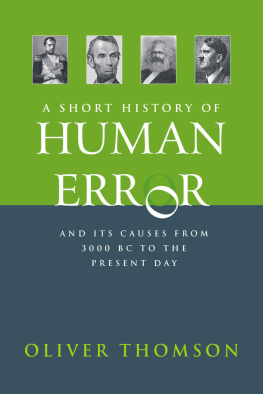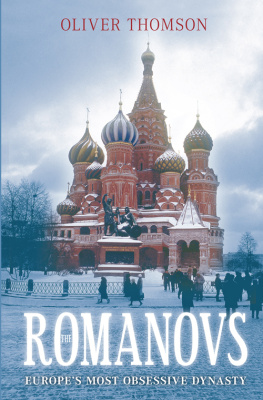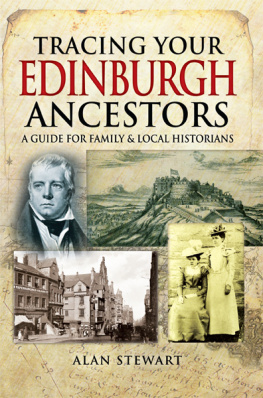THE
RISES & FALLS
OF THE
ROYAL STEWARTS
THE
RISES & FALLS
OF THE
ROYAL STEWARTS
OLIVER THOMSON
Arent any more than a steward?
William Shakespeare
First published in 2011
The History Press
The Mill, Brimscombe Port
Stroud, Gloucestershire, GL 5 2 QG
www.thehistorypress.co.uk
This ebook edition first published in 2011
All rights reserved
Oliver Thomson, 2009, 2011
The right of Oliver Thomson, to be identified as the Author of this work has been asserted in accordance with the Copyrights, Designs and Patents Act 1988.
This ebook is copyright material and must not be copied, reproduced, transferred, distributed, leased, licensed or publicly performed or used in any way except as specifically permitted in writing by the publishers, as allowed under the terms and conditions under which it was purchased or as strictly permitted by applicable copyright law. Any unauthorised distribution or use of this text may be a direct infringement of the authors and publishers rights, and those responsible may be liable in law accordingly.
EPUB ISBN 978 0 7524 7093 1
MOBI ISBN 978 0 7524 7094 8
Original typesetting by The History Press
Contents
*
* dates refer to approximate period of office or on the throne
Preface
This is very far from being the first book about the Stewarts but it is different from the others in at least four ways. Firstly it focuses not just on the better-known royals but on many of the other ambitious, sometimes devious men and women in this family who helped to boost or sometimes hinder the progress of the dynasty. Secondly, it is more a collage of biographies than a history, looking at the psychology rather than just the politics. Thirdly it relates the ups and downs of the family to the huge portfolio of properties that they owned, the castles, mansions and palaces that they lived in and which still survive. Finally, it gives more space to before and after the royal period, looking at the extraordinary manoeuvres, personalities and coincidences and the many fascinating drop-outs who tried to keep pace. Nor does it just end with the anti-climax that was Bonnie Prince Charlie but follows through to Bute, Castlereagh and other later Stewarts like Jeb, the dashing general of the American Civil War, or Don Jacobo Stuart, the Spanish naval captain who earned the respect of Nelson.
Note on Spelling of Names
I have tried to match the use of the three variant spellings Stewart, Stuart and Steuart as closely as possible to the common usage by specific branches of the family. In certain periods, however, some of them used at least two versions at the same time and particularly in the early period it would be wrong to suggest that some members of the family exclusively used one version or another. Similarly, for the Mac families mentioned I have in the earlier periods simply standardised to lower case Mac with capitalised letter to follow.
We have an additional problem in that the number of Christian names was relatively restricted, so we have a very large number of Johns, Jameses and Roberts; sometimes parents even had two children of the same name in case one of them died. To distinguish themselves they usually added the name of an estate or castle, but even this can be confusing as later in life they might have been given a better estate or title.
Acknowledgements
Thanks and love to my wife Jean and the family in Blanefield, Kirklee and Torbreck
Introduction
This is the story of the remarkable family of stewards who became Stewarts, then Royal Stewarts, then Stuarts. The interest in this thousand-year family saga lies not just in the fascination of the individual lives, remarkable as so many of them were, but in the cumulative thrust of successive generations, the genetics of ambition as year after year they schemed to achieve power, then sometimes carelessly threw it away. The family was remarkable in the first instance for its sheer power of survival: in twenty-four generations there was only one break in the direct male line. That came after six hundred years when they produced Mary Queen of Scots, although as she married a Stuart who fathered her heir, there was no break anyway.
The Stewarts were also remarkable for the length of time that they held on to sovereign power some 340 years, still nearly fifty years longer than the dynasty of Hanover-Windsor which came afterwards (due for its tercentenary in 2014), longer than the Bourbons in France (259 years), the Hohenzollerns in Prussia and Germany (217 years) or the Romanovs in Russia (304 years). Only one major dynasty in modern European history has exceeded their total: the Habsburgs in Austria (645 years with gaps.)
Yet compared to their longevity as a dynasty, the lives of the individuals were frequently violent and short. Of the fourteen Stewarts who wore a crown, eight failed to reach the age of fifty and only three (Robert II and Robert III of Scotland, James II of Great Britain) passed their sixtieth birthdays, bringing the average age at death to forty-seven. Six out of the fourteen died violent deaths: two were murdered (James I and James III), two were executed (Mary Queen of Scots and Charles I) and two were killed in battle (James II and James IV). The premature deaths were inevitably followed by premature accessions; while their average age for inheriting the crown was twenty-three, six came to the throne before their tenth birthdays and by a miracle survived the machinations of those who sought to take advantage of their youth.
Of the eleven Stewart kings, at least eight had frequent extramarital affairs, one was homosexual, and their queens not only had to suffer that indignity, but also in most cases early widowhood, followed by further misfortune when they remarried. All three of the regnant Stuart queens in Britain led largely miserable lives and produced only one surviving child between the three of them. Apart from Mary Queen of Scots brief episode as queen of France the only other Stewart to become a queen outside Britain, Elizabeth, Queen of Bohemia, had a normal family life but was driven out of Prague with her husband after only one year on the throne. Eleanor Stewart, the only Scottish princess to marry a Habsburg, also missed out on a crown as did her sister Margaret who married the future Louis XI of France but died before he became king.
Of the uncrowned members of the main family at least another hundred were murdered and about the same number (plus one king James II) were murderers themselves. At least double that number were executed and three times as many killed in battle. Many of them were highly talented and led exciting lives. There were fine generals like John Stewart Earl of Buchan, Marshal Bernard Stuart of France, Prince Rupert of the Rhine and James Fitzjames Duke of Berwick. There was one British prime minister, John Stuart, Earl of Bute and two foreign secretaries; Robert Stewart, Viscount Castlereagh who committed suicide and Michael Stewart, a former schoolmaster from London who became a Labour politician. In addition there were priests, explorers, artists, pirates, robbers, other assorted malefactors and ordinary working people. As well as their legitimate children most of the Royal Stewarts produced bastards whose careers are often even more exciting, like Janet Stewart who became mistress of Henri II of France.
Above all, this was a family whose huge ambition thrived on mobility. Having migrated from the Baltic to Brittany, they then after a few generations transferred to the Anglo-Welsh border, then to western Scotland, then to Edinburgh as kings of Scotland, then to London as kings of Britain, to France and Italy as exiles, finally throughout the English-speaking world, still prolific.









